Our look back at past elections in Special Collections is rounded off today with a gallery of from an impressive volume of East Derbyshire Election Cartoons, 1868. The book was printed and published by Richard John Smithson of Chesterfield.
Shown here are 21 political cartoons. Numbers 1-18 (Liberal Cartoons) were drawn by J. Priestman Atkinson, who worked for Punch. Two of the three Conservative Cartoons (19-20) are signed by Palmer & Edmunds Litho.”, while the third is unsigned. The election was the first to be fought following the 1867 Reform Act which gave the vote to occupiers in the boroughs (people who rented properties rather than owning them). The contest for East Derbyshire was a hard fought affair, with the Liberal candidates, Francis Egerton and Henry Strutt, victorious over their Conservative opponents by narrow margins. The volume of cartoons provides an insight into how elections were fought 150 years ago. It is apparently very rare: only the University of Leicester’s copy is listed on Copac. One explanation for its scarcity may be the fact that the publisher, Smithson, was declared bankrupt shortly after it was published (pdf).
According to the Preface, ‘During the Election the following Cartoons appeared week by week, and excited great interest on both sides. As works of art they may be left to speak for themselves; but, unless some key be given, “Times effacing finger” will soon prevent the identification of the persons delineated, and a thus deprive the drawings of much of their significance. They are therefore here collected, so as to admit of any written memoranda in regard to each which the possessors of the collection may deem desirable’. Each cartoon is interleaved with a blank page, so it seems that Smithson’s intention was for his customers to use them as a scrapbook for other ephemera from the election. The Special Collections copy contains no such material, but it would be interesting to know of other surviving copies that may have been used as intended.
- Title page
- No. 1. Great run out of season with the Barlow hounds.
- No. 2. A long pull, a strong pull, and a pull all-together
- No. 3. May good digestion wait on appetite, and health on both
- No. 4. “Similia similibus curantur”
- No. 5. “Which will win?”
- No. 6. De profundis
- No. 7. The thunderbolt
- No. 8. “Hic jacet”
- No. 9. “A leap in the dark”. Lord Derby.
- No. 10. “Paul Pry” in East Derbyshire
- No. 11. Too clever by half
- East Derbyshire Election Cartoons, 1868
- No. 13. Ye East Derbyshire Guy Fawkes!
- No. 14. “Tis my delight on a shiny night”
- 15. East Derbyshire – The Nomination
- No. 16. The Fall of the Curtain
- No. 17. “Sermons in Stones”
- No. 18. “Bolsover bowls overend”
- No. 19. The Radicals capsized by the Irish church life buoy
- No. 20. Knock-em-down

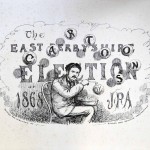
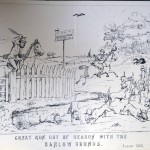
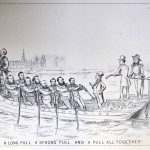
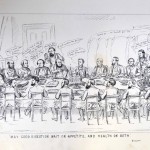
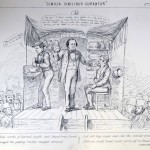
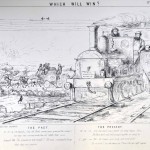
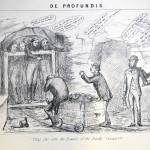
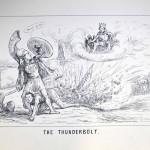
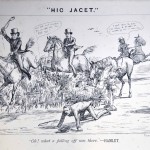
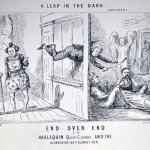
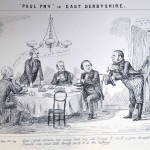
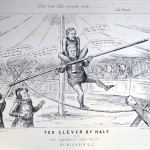
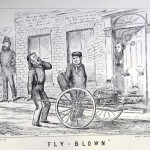
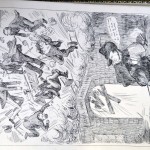
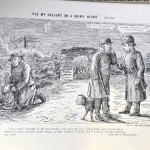
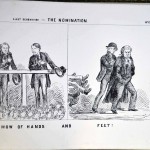
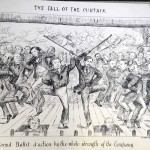
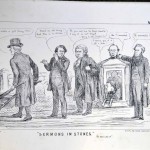
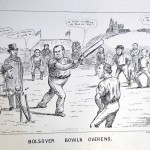
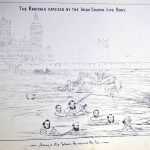
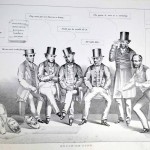

 Subscribe to Simon Dixon's posts
Subscribe to Simon Dixon's posts
It would perhaps be an interesting research project to attempt identification of the persons depicted in these cartoons. The Liberal agent at the time for the East Derbyshire constituency was Charles Stanhope Burke Busby (1814-1901), a Chesterfield solicitor and three-times Mayor of Chesterfield (1858, 1866, 1867). A short obituary in the Derbyshire Courier (20 July 1901, p.5) contains the following.
“As Liberal agent far the old division of East Derbyshire, too, Mr. Busby showed that he could organise as well as talk, and the famous struggle of 1868 resulted in a triumph for the Liberal party largely through his efforts. One of the most striking cartoons of the series issued during the
contest shows Mr. Busby in characteristic attitude in the Liberal boat issuing directions to the oarsmen.”
The Courier was a Liberal newspaper and the cartoons were advertised singly therein as they appeared, at 3d, for collection, or 4d by post. (See for example the issue of 26 September, 1868, p.2, advertising cartoon no. 7, which they name “BY JOVE!!”.)
The rival newspapaer was Conservative, the Derbyshire Times, and their comments (19 September 1868, p.3) on cartoon no. 5, “Which will win?”, includes the following.
“The Liberal cartoons don’t improve … the “Liberal” engine … represented as driven by the Duke of Devonshire’s agent, with Mr. Markham as fireman and stoker …”
The Duke of Devonshire’s agent was JG Cottingham.
Charles Markham was an important local industrialist.
This information is from just a few newspaper articles that I happen to have to hand in connection with a (very) little research that I have been doing into Charles Busby.
Thank you for your comment, Paul. I agree these cartoons would make a very interesting research project, for an article or student dissertation. Many thanks for providing this information.
We’re indebted to Janet Murphy for very kindly supplying the following additional information about the artist, who was identified in the Derbyshire Courier of 28th December 1895:
“Mr J P Atkinson – the artist in question – was, at one time, a clerk in the offices of the Midland Company at Derby, and achieved more than a local reputation by the work he did for the “Derby Ram”. Amongst his admirers and friends he numbered the late Mr Sterland Gratton, for so many years the land agent to the Midland Company, and it was the gentleman’s brother, Mr R T Gratton, of Chesterfield, who was chiefly instrumental in securing Mr Akinson’s artistic services in the 1868 election. It was necessary that Mr Atkinson should be brought into close contact with his subjects without arousing their suspicions, and during the greater part of his stay in Chesterfield he was known as Mr Priestman – the second of his Christion names – and the sketches were subsequently evolved at Mr Gratton’s house, where he stayed during the contest.”
I have this book. In good shape for it’s age.